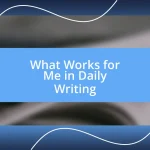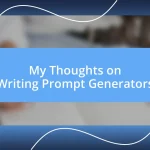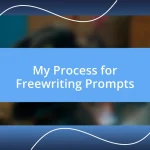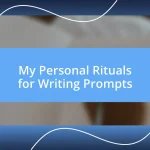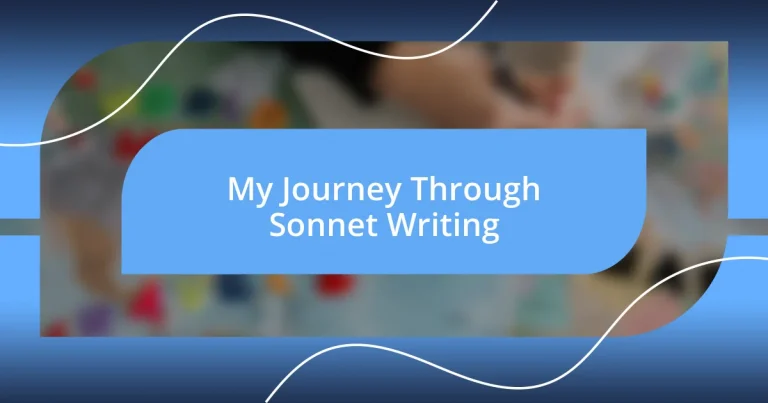Key takeaways:
- Sonnets have a strict 14-line structure that encourages creativity through constraints, with different forms like Shakespearean and Petrarchan shaping emotional expression.
- Effective imagery in sonnet writing enhances emotional depth, employing techniques such as sensory details, metaphors, and vivid verbs to create relatable experiences.
- Revising sonnets is crucial; reading aloud, cutting unnecessary words, and engaging with an audience during performance deepen the connection and clarity of the poem’s message.
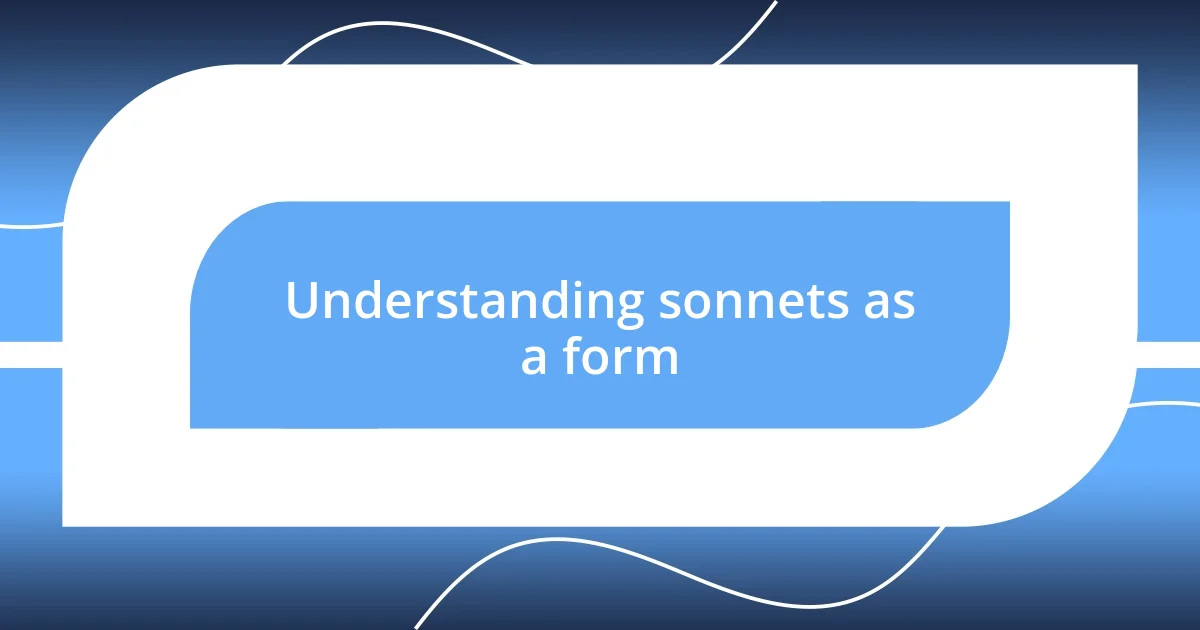
Understanding sonnets as a form
Sonnets, known for their strict form, always consist of 14 lines, typically following a specific rhyme scheme. I remember the first time I attempted to write one; I felt both excitement and intimidation. The constraints can sometimes feel stifling, but they challenge creativity in ways that freeform writing doesn’t — doesn’t that spark some curiosity?
Exploring the sonnet structure—like the Shakespearean with its ABABCDCDEFEFGG or the Petrarchan with its ABBAABBACDCDCD—can be fascinating. Have you ever wondered how these patterns influence emotional expression? I certainly did while crafting my own. Each shift between quatrains or the volta (the turn) provided me with an opportunity to deepen my message and evoke a different feeling in the reader.
What truly captivates me is how sonnets encapsulate moments or emotions so poignantly within their brief scope. I often find solace in the act of distilling my thoughts into such a confined space. It’s as if the limitations push me toward clarity, urging me to find the essence within the lyrical constraints.
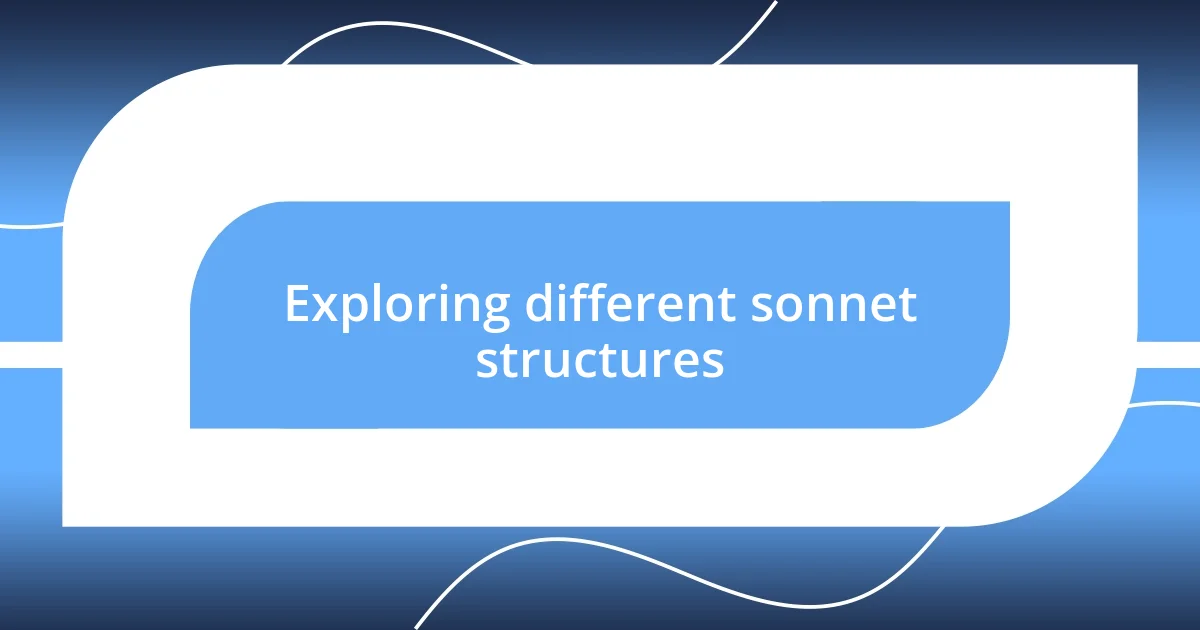
Exploring different sonnet structures
When I first delved into writing sonnets, I was struck by the differences in structure between the various forms. The Shakespearean sonnet, with its distinctive three quatrains and a final couplet, felt like a friendly conversation. In contrast, the Petrarchan’s octave and sestet structure seemed like a more formal discourse, elegantly transforming thoughts into profound insights. The way these forms shape what we express is something I deeply appreciate.
Taking a closer look at the Spenserian sonnet, I found its unique rhyme scheme of ABABBCBCCDCDEE intriguing. It creates a continuous flow that feels almost lyrical, as if the words wanted to dance off the page. This aspect encouraged me to explore themes of love and nature, harnessing the rhyme’s fluidity. I remember how I became lost in this rhythm, transforming fleeting thoughts into structured verses that felt both freeing and constraining.
I’ve also experimented with the curtal sonnet, a shorter form that condenses ideas into only ten and a half lines. This structure taught me to be succinct, stripping away excess baggage from my thoughts. The brevity prompted me to reflect on what truly mattered in my writing journey. Perhaps that’s why I cherish exploring different sonnet structures; they not only challenge me but also help me evolve as a poet.
| Sonnet Type | Rhyme Scheme |
|---|---|
| Shakespearean | ABABCDCDEFEFGG |
| Petrarchan | ABBAABBACDCDCD |
| Spenserian | ABABBCBCCDCDEE |
| Curtal | ABCABC DBCAB |

Techniques for effective imagery
Creating effective imagery in sonnet writing has been a game changer for me. It’s incredible how a well-chosen word can paint vivid pictures in the reader’s mind. When I first experimented with rich imagery, I felt like I was breathing life into my words. I learned to draw on my surroundings and personal experiences to enhance the emotional depth of my verses.
Here are some techniques that have worked wonders for me:
- Sensory Details: Use sights, sounds, tastes, touches, and smells to immerse your reader in the experience.
- Metaphors and Similes: These figures of speech can create connections and evoke emotions by comparing contrasting elements.
- Personification: Giving human characteristics to non-human elements can create empathy and a deeper understanding.
- Vivid Verbs: Strong, descriptive verbs energize your imagery and pull the reader into the scene more forcefully.
One memorable moment was when I wrote about a storm raging outside my window. The wind howled like a wild beast, and the rain lashed against the glass. In that vivid depiction, I found not just the weather, but also a reflection of my own inner turmoil. Imagery transformed my writing from mere words into something that resonated and connected with readers on a deeper level. It’s these techniques that allow me to capture fleeting emotions and moments, making my sonnets feel alive and relatable.
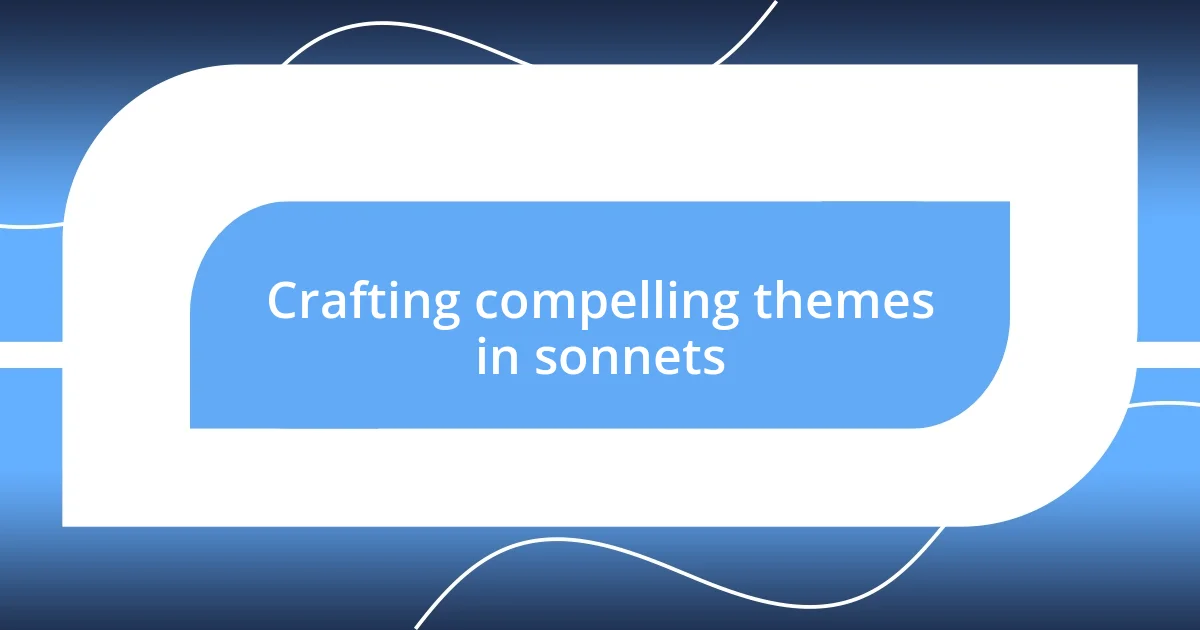
Crafting compelling themes in sonnets
Crafting compelling themes in sonnets has always been a fascinating challenge for me. I remember the first time I decided to tackle the theme of unrequited love. With each line, I was tasked with not just expressing longing, but capturing the essence of hope intertwined with despair. How can one convey such a complex emotion through the constraints of a sonnet? This question pushed me to dig deep into my own experiences and memories, allowing me to transform personal pain into universal truths.
One of my favorite themes to explore in sonnets is the passage of time. I’ve often found myself reflecting on moments that slipped away like sand through my fingers. The power of this theme lies in its relatability; everyone has felt the fleeting nature of life. When writing about it, I’ve employed imagery of seasons changing, drawing a parallel between the beauty of nature and the inevitability of change. This connection resonated with my readers, sparking conversations about their own encounters with time.
As I navigated through themes of identity, I discovered the richness of self-exploration. It was during this journey that I penned a sonnet reflecting on cultural heritage. I drew from vivid memories of family gatherings, the sound of laughter, and the aroma of home-cooked meals. It became a way to celebrate my roots while acknowledging the complexities of modern life. In sharing these themes, I realize that sonnets can transcend mere structure, transforming into vessels for deeper exploration of life’s intricate layers. Don’t you find that in capturing these moments, we not only tell our stories but also invite others to reflect on their own?
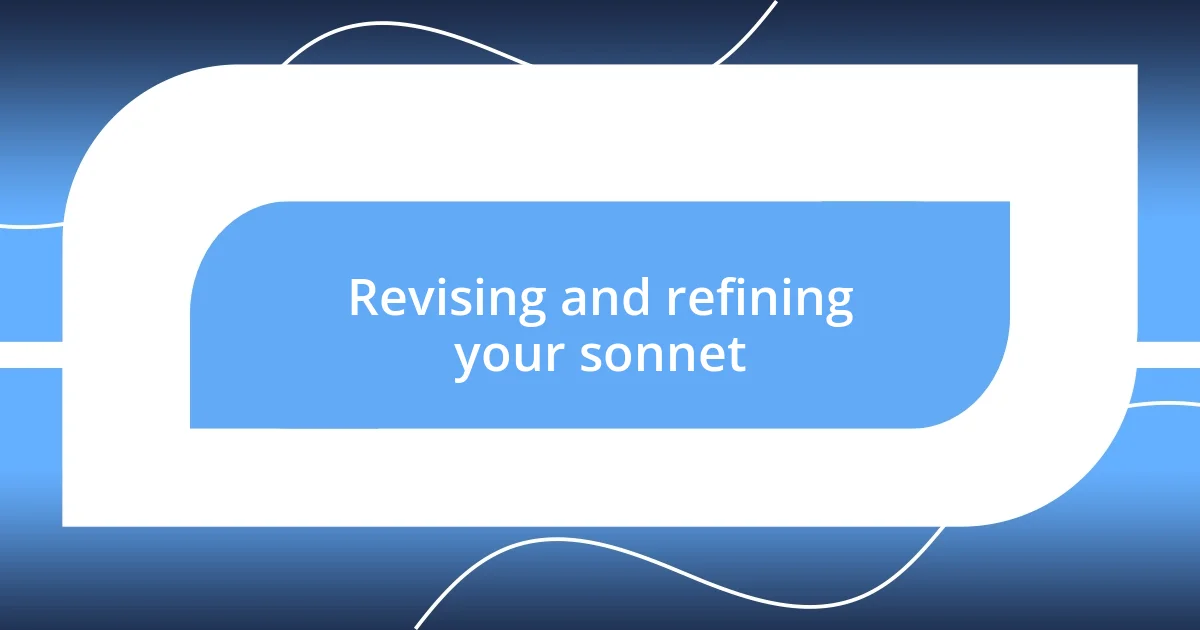
Revising and refining your sonnet
Revising and refining a sonnet is where the magic truly happens for me. It’s like sculpting a block of marble; at first, there’s a rough shape, but with careful chipping away, the beauty starts to reveal itself. I often find that when I step back from my draft and revisit it later, new perspectives emerge. Have I captured the true essence of what I wanted to say? Sometimes, a fresh set of eyes—whether my own after a break or those of a trusted friend—can illuminate what needs to change.
One technique I swear by is reading my sonnet aloud. This practice not only helps me catch awkward phrasing but also lets me feel the rhythm and flow of the lines. I recall one night spent in the glow of my desk lamp, where the sound of my own voice breathed new life into a particularly stubborn couplet. Suddenly, a line that felt clunky transformed into something fluid and evocative. It’s these little revelations that remind me of the importance of sound in poetry.
Furthermore, cutting words can be an emotional yet liberating experience. I remember grappling with a line filled with elaborate adjectives that felt clever at first but ultimately distracted from the core message. Letting go of those words felt like shedding weight; it allowed the poem to breathe and connect more effortlessly with readers. Each revision teaches me that sometimes, less really is more, and clarity should always reign supreme in conveying my message. Isn’t it fascinating how the process can lead to such personal growth?

Sharing and performing your sonnet
Sharing a sonnet can feel like standing on a stage, baring your soul for everyone to see. I vividly remember the first time I read my sonnet aloud at a local poetry night. My heart raced as I delivered each line, and the weight of vulnerability hung in the air. But then, as I glanced at the faces of the audience, I saw nods of understanding and smiles of recognition. In that moment, I realized the profound connection that poetry can forge between strangers.
Performing a sonnet is not merely about recitation; it’s about bringing the words to life. I’ve often practiced in front of my mirror, experimenting with tone and pauses to convey the emotion embedded in the lines. It’s fascinating how the right emphasis on a word can transform a feeling, isn’t it? I recall a particular sonnet about loss where I chose to slow my pace during the climax, letting the weight of sorrow linger in the room. The feedback was incredible; several listeners shared that they felt the intensity of the moment long after I had finished.
After sharing one of my sonnets, I found it rewarding to engage in discussion with the audience. Their perspectives often opened my eyes to interpretations I hadn’t considered before. This exchange does more than validate my experience; it enriches my understanding of the themes I explore. Have you ever noticed how a simple conversation can breathe new life into your work? Each interaction reminds me that my words have the power to resonate and evoke emotions, creating a shared journey through the beauty of sonnet writing.
